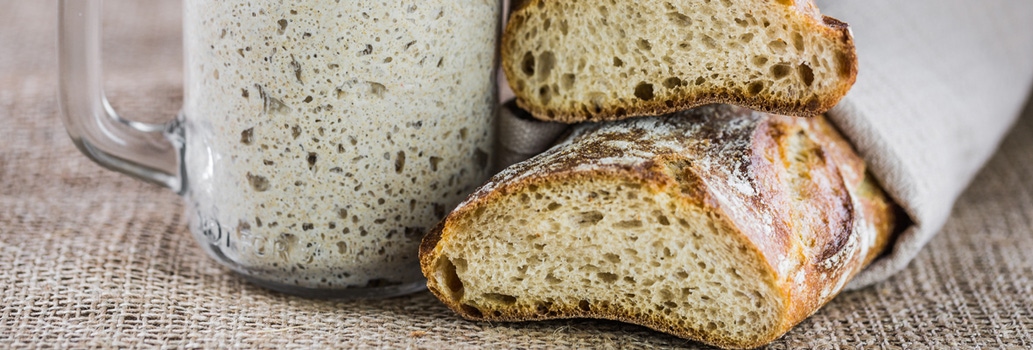
Food in Focus: Sourdough
Sourdough is the bread baking project everyone seems to be trying at home. That may be because of the challenge to bake a perfect loaf, or because it’s just so tasty. Regardless of the reason, if you’ve become a sourdough fan the good news is your gut will be happy too.
Sourdough is a bread created using one of the oldest forms of grain fermentation. In fact it’s thought to originate in Egypt, in 1,500 BC.
Regular, store-bought breads are made using baker’s yeast to help it rise. Sourdough gets its unique air-filled or open crumb texture using a traditional process that combines ‘wild’ yeast and the lactic acid in flour, to create a ‘starter culture’.
During the bread-making process, the culture ferments the naturally occurring sugars found in dough to help it rise, giving the bread its distinct flavour.
The prebiotic grain fibres and fermentation from the starter culture make it naturally beneficial food for the gut.
Like other fermented foods, the actual fermentation process creates a lot of goodness. The lactic acid in sourdough breakdowns the grains and makes it easier for your body to absorb iron, zinc, magnesium and phosphate from the bread. The fermentation is also believed to release additional antioxidants and create more folate.
Sourdough is also relatively low-GI, meaning after eating sourdough, blood glucose levels will be steadier. This makes sourdough a good choice for those with type two diabetes or insulin resistance.
Sourdough bread is usually made with wheat, barley or rye flour and should be avoided by people with gluten intolerance or coeliac disease.
However, the sourdough fermentation does reduce, although not completely degrade, gluten in the bread. This may make it easier to digest and could make it more tolerable for people looking to reduce their gluten intake.
If you are on a low FODMAP diet, you may be able to enjoy sourdough if it’s been made using traditional methods. During its long proving process, the yeast and bacteria feed on the carbohydrates in the flour and start breaking down the FODMAPs. This forms air bubbles in the dough, helps the bread to rise, and creates a bread with a reduced FODMAP content. Chat with your Dietitian to see if sourdough is right for you.
All good things take time, and sourdough is no exception. Just creating a sourdough starter can take between 4 and 24 hours. Luckily you can also buy a starter as a short-cut to get baking.
Some other top sourdough baking tips?
What is sourdough?
Sourdough is a bread created using one of the oldest forms of grain fermentation. In fact it’s thought to originate in Egypt, in 1,500 BC. Regular, store-bought breads are made using baker’s yeast to help it rise. Sourdough gets its unique air-filled or open crumb texture using a traditional process that combines ‘wild’ yeast and the lactic acid in flour, to create a ‘starter culture’.
During the bread-making process, the culture ferments the naturally occurring sugars found in dough to help it rise, giving the bread its distinct flavour.
Why is sourdough better for you than white bread?
The prebiotic grain fibres and fermentation from the starter culture make it naturally beneficial food for the gut. Like other fermented foods, the actual fermentation process creates a lot of goodness. The lactic acid in sourdough breakdowns the grains and makes it easier for your body to absorb iron, zinc, magnesium and phosphate from the bread. The fermentation is also believed to release additional antioxidants and create more folate.
Sourdough is also relatively low-GI, meaning after eating sourdough, blood glucose levels will be steadier. This makes sourdough a good choice for those with type two diabetes or insulin resistance.
Can you eat sourdough if you are gluten intolerant or on a low FODMAP diet?
Sourdough bread is usually made with wheat, barley or rye flour and should be avoided by people with gluten intolerance or coeliac disease. However, the sourdough fermentation does reduce, although not completely degrade, gluten in the bread. This may make it easier to digest and could make it more tolerable for people looking to reduce their gluten intake.
If you are on a low FODMAP diet, you may be able to enjoy sourdough if it’s been made using traditional methods. During its long proving process, the yeast and bacteria feed on the carbohydrates in the flour and start breaking down the FODMAPs. This forms air bubbles in the dough, helps the bread to rise, and creates a bread with a reduced FODMAP content. Chat with your Dietitian to see if sourdough is right for you.
Making your own sourdough
All good things take time, and sourdough is no exception. Just creating a sourdough starter can take between 4 and 24 hours. Luckily you can also buy a starter as a short-cut to get baking. Some other top sourdough baking tips?
- Be patient and keep the area where you’re growing your culture very clean.
- Practice makes perfect!
- Use trial and error to experiment with different flours or even sprouted grains. You can also make sourdough even better for you by subbing out the white flour for rye or wholegrain flour, which are more nutrient-dense than white flour and offer more dietary fibre as well as the many other nutritional benefits of wholegrains.
The bottom line
For the bread lovers out there, sourdough is a healthier, more easily digestible bread, so it’s worth getting your hands on some – or even better, making it yourself.
The latest nutrition advice, plus health and wellness tips delivered to your inbox monthly

